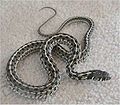| Image | Name | Subspecies | Distribution |
|---|
| Thamnophis ahumadai C. Grünwald, Mendoza-Portilla, A. Grünwald, Montaño-Ruvalcaba, Franz-Chávez, García-Vázquez, & Reyes-Velasco, 2024 [20] | | Jalisco Mountain, Mexico |
 | Aquatic garter snake, Thamnophis atratus (Kennicott, 1860) | | coast of Oregon and California. |
| Bogert's garter snake, Thamnophis bogerti Rossman & Burbrink, 2005 | | Oaxaca, Mexico |
| Shorthead garter snake, Thamnophis brachystoma (Cope, 1892) | | northwestern Pennsylvania and southwestern New York. |
 | Butler's garter snake, Thamnophis butleri (Cope, 1889) | | northwestern Ohio, northeastern Indiana, the eastern portion of the Lower Peninsula of Michigan, and the adjacent extreme southern tip of Ontario, Canada. |
| Goldenhead garter snake, Thamnophis chrysocephalus (Cope, 1885) | | Mexico. |
| Conant's garter snake, Thamnophis conanti Rossman & Burbrink, 2005 | | Puebla and Veracruz, Mexico. |
| Cope's mountain meadow snake, Thamnophis copei Dugès, 1879 | | Mexico. |
 | Sierra garter snake, Thamnophis couchii (Kennicott, 1859) | | California and Oregon in the United States |
 | Blackneck garter snake, Thamnophis cyrtopsis (Kennicott, 1860) | - Western blackneck garter snake, T. c. cyrtopsis(Kennicott, 1860)
- Eastern blackneck garter snake, T. c. ocellatus(Cope, 1880)
- Tropical blackneck garter snake, T. c. collaris(Jan, 1863)
| southwestern United States, Mexico and Guatemala |
 | Western terrestrial garter snake, Thamnophis elegans (Baird & Girard, 1853) | - Arizona garter snake, T. e. arizonae W. Tanner & Lowe, 1989
- Mountain garter snake, T. e. elegans(Baird & Girard, 1853)
- San Pedro Mártir garter snake, T. e. hueyi Van Denburgh & Slevin, 1923
- Coastal garter snake, T. e. terrestris Fox, 1951
- Wandering garter snake, T. e. vagrans(Baird & Girard, 1853)
- Upper Basin garter snake, T. e. vascotanneriW. Tanner & Lowe, 1989
| central British Columbia, central Alberta, and southwestern Manitoba in Canada, central United States |
 | Mexican garter snake, Thamnophis eques (Reuss, 1834) | - Mexican garter snake, T. e. eques(Reuss, 1834)
- Laguna Totolcingo garter snake, T. e. carmenensis Conant, 2003
- T. e. cuitzeoensisConant, 2003
- T. e. diluvialisConant, 2003
- T. e. insperatusConant, 2003
- Northern Mexican garter snake, T. e. megalops(Kennicott, 1860)
- T. e. obscurusConant, 2003
- T. e. patzcuaroensisConant, 2003
- T. e. scottiConant, 2003
- T. e. virgatenuisConant, 1963
| Mexico and in the United States (Arizona and New Mexico). |
 | Mexican wandering garter snake, Thamnophis errans H. M. Smith, 1942 | | Chihuahua, Durango, Jalisco, Nayarit, and Zacatecas States of Mexico. |
| Montane garter snake, Thamnophis exsul Rossman, 1969 | | Mexico. |
| Fox's mountain meadow snake, Thamnophis foxi Rossman & Blaney, 1968 | | Mexico. |
| Highland garter snake, Thamnophis fulvus (Bocourt, 1893) | | Mexico, Guatemala, Honduras and El Salvador. |
 | Giant garter snake, Thamnophis gigas Fitch, 1940 | | central California. |
| Godman's garter snake, [21] Thamnophis godmani (Günther, 1894) | | southern Mexico |
 | Two-striped garter snake, Thamnophis hammondii (Kennicott, 1860) | | central California to Baja California, Mexico |
| Liner's garter snake, Thamnophis lineri [22] Rossman & Burbrink, 2005 | | Mexico. |
 | Checkered garter snake, Thamnophis marcianus (Baird & Girard, 1853) | - T. m. marcianus(Baird & Girard, 1853)
- T. m. praeocularis(Bocourt, 1892)
- T. m. bovalli(Dunn, 1940)
| southwestern United States, Mexico, and Central America. |
 | Blackbelly garter snake, Thamnophis melanogaster (Peters, 1864) | | Mexico. |
| Tamaulipan montane garter snake, Thamnophis mendax Walker, 1955 | | Mexico. |
| Southern Durango spotted garter snake, Thamnophis nigronuchalis Thompson, 1957 | | Durango, Mexico. |
 | Northwestern garter snake, Thamnophis ordinoides (Baird & Girard, 1852) | | California, Oregon, and Washington; in Canada, it is found in British Columbia |
| Tepalcatepec Valley garter snake, Thamnophis postremus Smith, 1942 | | Mexico. |
 | Western ribbon snake, Thamnophis proximus (Say, 1823) | - Chiapas Highlands ribbon snake, T. p. alpinusRossman, 1963
- Arid land ribbon snake, T. p. diabolicusRossman, 1963
- Gulf Coast ribbon snake, T. p. orariusRossman, 1963
- Orangestripe ribbon snake or western ribbon snake T. p. proximus(Say, 1823)
- Redstripe ribbon snake, T. p. rubrilineatusRossman, 1963
- Mexican ribbon snake, T. p. rutiloris(Cope, 1885)
| western United States, Mexico, and Central America |
 | Yellow-throated garter snake, Thamnophis pulchrilatus (Cope, 1885) | | Mexico. |
 | Plains garter snake, Thamnophis radix (Baird & Girard, 1853) | | central United States as far north as Canada and as far south as Texas. |
| Rossman's garter snake, Thamnophis rossmani Conant, 2000 | | Mexico. |
| Narrow-headed garter snake, Thamnophis rufipunctatus (Cope, 1875) | | Arizona and New Mexico, and in the Mexican states of Sonora, Chihuahua and Durango |
 | Ribbon snake, Thamnophis saurita (Linnaeus, 1766) | | Eastern North America |
 | Longtail alpine garter snake, Thamnophis scalaris (Cope, 1861) | | Mexico. |
| Short-tail alpine garter snake, Thamnophis scaliger (Jan, 1863) | | Mexico. |
 | Common garter snake, Thamnophis sirtalis (Linnaeus, 1758) | - Texas garter snake, T. s. annectens Brown, 1950
- Red-spotted garter snake, T. s. concinnus(Hallowell, 1852)
- New Mexico garter snake, T. s. dorsalis(Baird & Girard, 1853)
- valley garter snake, T. s. fitchiFox, 1951
- California red-sided garter snake, T. s. infernalis(Blainville, 1835)
- T. s. lowei W. Tanner, 1988
- Maritime garter snake, T. s. pallidulus Allen, 1899
- Red-sided garter snake, T. s. parietalis(Say, 1823)
- Puget Sound garter snake, T. s. pickeringii(Baird & Girard, 1853)
- Blue-striped garter snake, T. s. similisRossman, 1965
- Eastern garter snake, T. s. sirtalis(Linnaeus, 1758)
- Chicago garter snake, T. s. semifasciatus(Cope, 1892)
- San Francisco garter snake, T. s. tetrataenia(Cope, 1875)
| North America |
| Sumichrast's garter snake, Thamnophis sumichrasti (Cope, 1866) | | Mexico. |
| Madrean narrow-headed garter snake, Thamnophis unilabialis W. Tanner, 1985 | | Mexico. |
| West Coast garter snake, Thamnophis validus (Kennicott, 1860) | | Mexico. |
|























